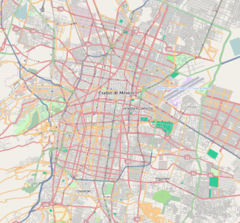Popotla metro station
| STC rapid transit | |||||||||||
 Station entrance sign, 22 December 2006 | |||||||||||
| General information | |||||||||||
| Location | Calzada México-Tacuba Popotla, Miguel Hidalgo Mexico City Mexico | ||||||||||
| Coordinates | 19°27′08″N 99°10′29″W / 19.452147°N 99.1747°W | ||||||||||
| Operated by | Sistema de Transporte Colectivo (STC) | ||||||||||
| Line(s) | |||||||||||
| Platforms | 2 side platform | ||||||||||
| Tracks | 2 | ||||||||||
| Construction | |||||||||||
| Structure type | Underground | ||||||||||
| Other information | |||||||||||
| Status | In service | ||||||||||
| History | |||||||||||
| Opened | 14 September 1970 | ||||||||||
| Passengers | |||||||||||
| 2023 | 2,804,236[1] | ||||||||||
| Rank | 136/195[1] | ||||||||||
| Services | |||||||||||
| |||||||||||
| |||||||||||
Popotla is a station on Line 2 of the Mexico City Metro system. It is located in the Colonia Popotla neighborhood of the Miguel Hidalgo borough of Mexico City, northwest of the city center, on the Calzada México-Tacuba.[2][3] In 2019 the station had an average ridership of 10,000 passengers per day, making it the least used station on Line 2.[4]
Name and pictogram
[edit]The name of the station comes from the neighborhood it serves: Popotla. The logo depicts an ahuehuete tree, referring to the Árbol de la Noche Triste – the "tree of the sad night" – where Spanish conquistador Hernán Cortés stopped his retreat from Tenochtitlán and cried after being defeated by Cuitláhuac in the Battle of Noche Triste.[2][3] The actual tree survived until the 20th century, when it was destroyed by a fire. There is a commemorative plaque on the site where the tree used to be.
General information
[edit]The station was opened on 14 September 1970 as part of the second stretch of Line 2, from Pino Suárez to Tacuba.[5] Metro Popotla serves the neighborhood of the same name.
From 23 April to 24 June 2020, the station was temporarily closed due to the COVID-19 pandemic in Mexico.[6][7]
Ridership
[edit]| Annual passenger ridership | |||||
|---|---|---|---|---|---|
| Year | Ridership | Average daily | Rank | % change | Ref. |
| 2023 | 2,804,236 | 7,682 | 136/195 | +12.85% | [1] |
| 2022 | 2,484,958 | 6,808 | 140/195 | +78.75% | [1] |
| 2021 | 1,390,202 | 3,808 | 159/195 | −3.38% | [8] |
| 2020 | 1,438,795 | 3,931 | 172/195 | −60.58% | [9] |
| 2019 | 3,650,212 | 10,000 | 154/195 | −0.80% | [4] |
| 2018 | 3,679,693 | 10,081 | 153/195 | +0.20% | [10] |
| 2017 | 3,672,167 | 10,060 | 150/195 | −2.49% | [11] |
| 2016 | 3,766,005 | 10,289 | 147/195 | −2.36% | [12] |
| 2015 | 3,857,093 | 10,567 | 135/195 | +3.41% | [13] |
| 2014 | 3,729,954 | 10,219 | 136/195 | −5.92% | [14] |
Nearby
[edit]- Universidad del Ejército y Fuerza Aérea, university of the Mexican Army and the Air Force
Entrances
[edit]- North: Calzada México-Tacuba and Callejón de la Zanja, Popotla
- North: Calzada México-Tacuba and Colegio Militar street, Popotla
See also
[edit]References
[edit]- ^ a b c d "Afluencia de estación por línea 2023" [Station traffic per line 2023] (in Spanish). Sistema Transporte Colectivo Metro. 2024. Archived from the original on 27 January 2024. Retrieved 24 January 2024.
- ^ a b "Popotla" (in Spanish). Archived from the original on 31 January 2012. Retrieved 16 August 2011.
- ^ a b Archambault, Richard. "Popotla » Mexico City Metro System". Retrieved 16 August 2011.
- ^ a b "Afluencia de estación por línea 2019" [Station traffic per line 2019] (in Spanish). Sistema Transporte Colectivo Metro. 2020. Archived from the original on 8 April 2020. Retrieved 3 May 2020.
- ^ Monroy, Marco. Schwandl, Robert (ed.). "Opening Dates for Mexico City's Subway". Retrieved 15 August 2011.
- ^ "Cierre temporal de estaciones" (PDF) (in Spanish). Metro CDMX. Retrieved 25 April 2020.
- ^ Hernández, Eduardo (13 June 2020). "Coronavirus. Este es el plan para reabrir estaciones del Metro, Metrobús y Tren ligero". El Universal (in Spanish). Retrieved 15 June 2020.
- ^ "Afluencia de estación por línea 2021" [Station traffic per line 2021] (in Spanish). Sistema Transporte Colectivo Metro. 2022. Archived from the original on 7 March 2022. Retrieved 7 March 2022.
- ^ "Afluencia de estación por línea 2020" [Station traffic per line 2020] (in Spanish). Sistema Transporte Colectivo Metro. 2021. Archived from the original on 21 June 2021. Retrieved 21 June 2021.
- ^ "Afluencia de estación por línea 2018" [Station traffic per line 2018] (in Spanish). Sistema Transporte Colectivo Metro. 2019. Archived from the original on 6 June 2019. Retrieved 7 April 2020.
- ^ "Afluencia de estación por línea 2017" [Station traffic per line 2017] (in Spanish). Sistema Transporte Colectivo Metro. 2019. Archived from the original on 3 May 2020. Retrieved 3 May 2020.
- ^ "Afluencia de estación por línea 2016" [Station traffic per line 2016] (in Spanish). Sistema Transporte Colectivo Metro. 2017. Archived from the original on 3 May 2020. Retrieved 3 May 2020.
- ^ "Afluencia de estación por línea 2015" [Station traffic per line 2015] (in Spanish). Sistema Transporte Colectivo Metro. 2016. Archived from the original on 3 May 2020. Retrieved 6 May 2020.
- ^ "Afluencia de estación por línea 2014" [Station traffic per line 2014] (in Spanish). Sistema Transporte Colectivo Metro. 2015. Archived from the original on 3 May 2020. Retrieved 6 May 2020.


